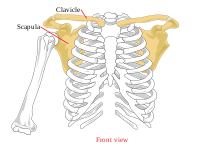
Photo from wikipedia
Background Obstetric brachial plexus injury (OBPI) remains a fairly common problem in newborns despite the improved obstetric care. Children who do not show complete recovery often present with residual shoulder… Click to show full abstract
Background Obstetric brachial plexus injury (OBPI) remains a fairly common problem in newborns despite the improved obstetric care. Children who do not show complete recovery often present with residual shoulder deformity of limited external rotation and abduction. Secondary interventions in the form of tendon transfer and soft tissue release are aimed at correcting the implicated muscular imbalance to restore shoulder function. Aim The aim of this work was to compare the results of latissimus dorsi versus teres major tendon transfer in patients with OBPI with limited shoulder external rotation. Patients and Methods This study included 40 patients admitted to El Hadara University Hospital with OBPI and limited shoulder abduction and external rotation aged between 1.5 and 4 years. Half of the patients had a latissimus dorsi transfer, and the other half, a teres major one. Children with limited preoperative passive external rotation in both groups required a subscapularis slide. Patients were evaluated preoperatively, at 6 months, and 12 months postoperatively using the Gilbert scale. Results Teres major tendon transfer showed better results in restoring limited shoulder abduction and external rotation than latissimus dorsi transfer. Limited shoulder internal rotation was the main complication occurring postoperatively. Loss of the last degree of internal rotation occurred in most patients who had subscapularis slide. Most patients regained functional midline abilities with physiotherapy and required no further interventions. Conclusions Isolated teres major transfer has shown better results in improving the range of external rotation and abduction compared with isolated latissimus dorsi tendon transfer. Age of the patients did not affect the overall final improvement in shoulder range of motion. Limited internal rotation is the main complication postoperatively, which was prevalent in patients who required a subscapularis slide but was not statistically significant.
Journal Title: Annals of Plastic Surgery
Year Published: 2023
Link to full text (if available)
Share on Social Media: Sign Up to like & get
recommendations!